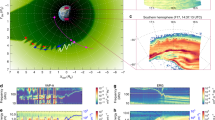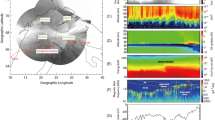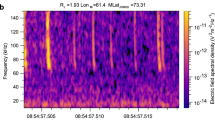Abstract
The Voyager Planetary Radio Astronomy (PRA) experiments detected an impulsive (15–400 ms), broadband (20 kHz to 40 MHz) radio emission component that persisted throughout the two Saturn encounter periods1,2. These bursts were grouped into episodes which recurred with a period of about 10 h 10 min, distinctly faster than the saturnian rotation period of 10 h 39.4 min (refs 1–5). This periodicity, coupled with the occurrence dependence on distance from Saturn, led Warwick et al.1 to conclude that the bursts were related to the Saturn system and coined the term SED for Saturn electrostatic discharges. We have analysed these SED episodes paying particular attention to their occurrence in both time and frequency as a function of spacecraft–Saturn geometry during the Voyager 1 encounter. We conclude that the characteristics of SED are best explained by a long-lived atmospheric lightning storm or systems of storms in Saturn's equatorial zone. From our model, we infer the ionospheric electron density near Saturn's noon meridian and over the night hemisphere.
This is a preview of subscription content, access via your institution
Access options
Subscribe to this journal
Receive 51 print issues and online access
$199.00 per year
only $3.90 per issue
Buy this article
- Purchase on Springer Link
- Instant access to full article PDF
Prices may be subject to local taxes which are calculated during checkout
Similar content being viewed by others
References
Warwick, J. W. et al. Science 212, 239–243 (1981).
Warwick, J. W. et al. Science 215, 582–587 (1982).
Evans, D. R., Warwick, J. W., Pearce, J. B., Carr, T. D. & Schauble, J. J. Nature 292, 716–718 (1981).
Evans, D. R. et al. Nature 299, 236–237 (1982).
Evans, D. R., Romig, J. H. & Warwick, J. W. Icarus (in the press).
Moore, J. H. Pub. astr. Soc. Pacif. 51, 274–281 (1939).
Smith, B. A. et al. Science 212, 163–191 (1981).
Smith, B. A. et al. Science 215, 504–537 (1982).
Kliore, A. J. et al. Science 207, 446–449 (1980).
Tyler, G. L. et al. Science 212, 201–206 (1981).
Tyler, G. L. et al. Science 215, 553–558 (1982).
Burns, J. A., Showalter, M. R., Cuzzi, J. N. & Durisen, R. H. Icarus (in the press).
Desch, M. D. & Kaiser, M. L. Geophys. Res. Lett. 8, 253–256 (1981).
Bauer, S. J. Physics of Planetary Ionospheres 178–194 (Springer, New York, 1973).
Atreya, S. K. & Waite, J. H. Nature 292, 682–683 (1981).
Waite, J. H. thesis, Univ. Michigan (1981).
Author information
Authors and Affiliations
Rights and permissions
About this article
Cite this article
Kaiser, M., Connerney, J. & Desch, M. Atmospheric storm explanation of saturnian electrostatic discharges. Nature 303, 50–53 (1983). https://doi.org/10.1038/303050a0
Received:
Accepted:
Issue Date:
DOI: https://doi.org/10.1038/303050a0
This article is cited by
-
A giant thunderstorm on Saturn
Nature (2011)
-
Atmospheric Electricity at Saturn
Space Science Reviews (2008)
-
Ground-Based and Space-Based Radio Observations of Planetary Lightning
Space Science Reviews (2008)
Comments
By submitting a comment you agree to abide by our Terms and Community Guidelines. If you find something abusive or that does not comply with our terms or guidelines please flag it as inappropriate.



